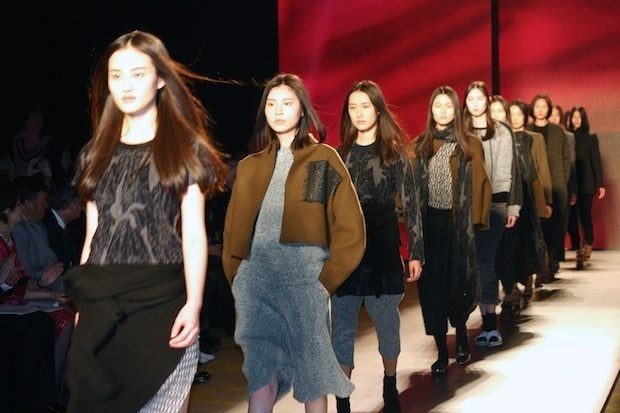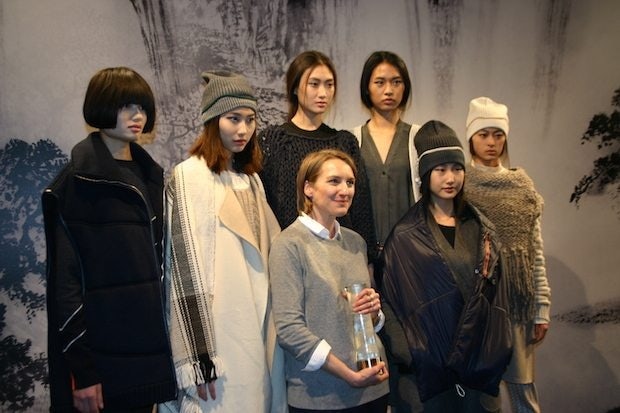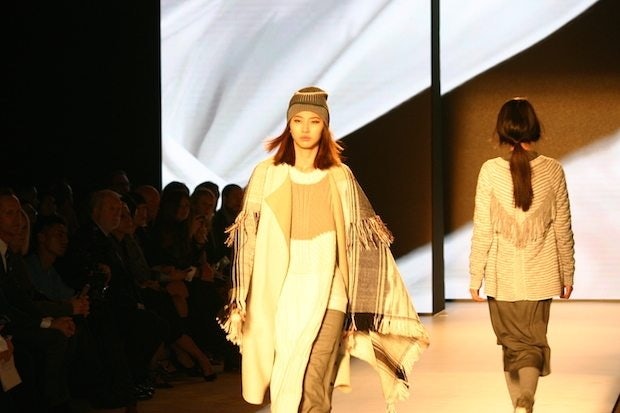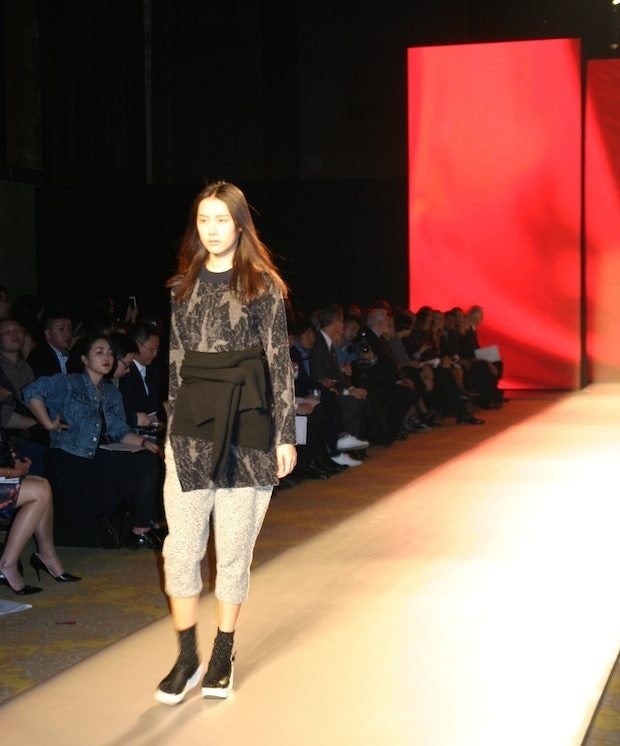
Looks by Chinese entry VMajor at the International Woolmark Prize womenswear finals in Beijing on March 17, 2015. (Jing Daily)
The top global fashion prize that launched the careers of Karl Lagerfeld, Yves Saint Laurent, Donna Karan, Ralph Lauren, Dolce & Gabbana, and Giorgio Armani held its global womenswear finals in Beijing on Tuesday, marking the first time the event has ever been held in mainland China.
On March 17, the final runway show for the prestigious International Woolmark Prize in Beijing’s Haidian district was attended by a high-caliber judging panel of global fashion luminaries including Vogue China Editor-in-Chief Angelica Cheung, fashion designer Victoria Beckham, and Vogue Italia Editor-in-Chief Franca Sozzani. Featuring the collections of regional winners hailing from China, the United States, Australia, Lebanon, and Germany, the show gave the final award to Marcia Patmos for her U.S. brand M.Patmos.
“This year’s entries were all at a very high level,” Cheung said in Chinese backstage after the show. She noted that the American label’s concept “is very unified, and it’s also very global, very international, and very modern.”

International Woolmark Prize womenswear winner Marcia Patmos with looks from her label M.Patmos at the finals in Beijing on March 17, 2015. (Jing Daily)
She also believed that Chinese entry VMajor was a strong candidate for the prize, stating, “I think the Chinese designers were really quite good; it’s kind of a pity they didn’t win. Several judges liked them. Personally, I think their design—from the planning stage, to the selection of materials, to the patterns, to completion, to production—was all very strong.”
Thanks to her involvement with the Woolmark Prize, Cheung had a major role in the selection of China for the location this year. “We wanted to make sure we had the support of the industry and the support of the publishers—in particular Angelica Cheung,” said Stuart McCullough, the CEO of Woolmark parent company Australian Wool Innovation (AWI), when asked about why China was chosen. “She agreed to support the program if we did it in Beijing and assist with the industry to help get them behind it.”
Although the event is often associated with global “fashion capitals”—it was held in Milan last year—the choice of Beijing is a sign of Chinese consumers’ massive influence on the fashion industry, particularly when it comes to wool consumption. AWI is particularly focused on promoting Australian wool for use in high-end fashion, especially Merino wool. “The world’s attention has been on China, so they’re coming here because they represent the wool manufacturers, and obviously China is a big consumer market for wool, so from that regard it’s important,” said Cheung.
According to McCullough, China buys 80 percent of all Australian wool, and consumer demand for high-quality fashion made out of the fabric is rising. “China is now consuming half of the what they process from us, so it’s gone from being just a converter of wool to a consumer of wool as well. And that’s going to continue to grow as China becomes more affluent, more wealthy—they will want to buy luxury.”

A look by competition winner M.Patmos at the International Woolmark Prize womenswear finals in Beijing. (Jing Daily)
McCullough notes that he was originally planning to hold this year’s event in New York, but decided that the current Year of the Sheep would be the optimal time to hold the wool-focused event in Beijing. According to Cheung, “We’re very happy that the event was held in China here this year. It was originally planned for next year, but this year is the Year of the Sheep and people are paying a lot of close attention to China.”
The event is a major stepping stone for up-and-coming Chinese designers, according to Cheung. “I do encourage young Chinese designers to participate in this competition because while it’s good to win the prize, the actual journey is very important,” she said. “As a young designer, it’s very hard to meet so many fashion experts, retail experts—to know them and to be known by them, and also to learn from the process.” The event has signed major luxury retail partners from around the world including 10 Corso Como, Saks Fifth Avenue, and Harvey Nichols.
VMajor designer Victor Zhu, who runs the Shenzhen-based label in partnership with Nicole Lin, agrees. “For us, it means everything,” to participate in the program, he stated. “It really pushes us on the international platform.” He said that he hopes to focus on the Chinese market before branching out internationally. “We’re concentrating on the domestic market at the moment,” he stated, nothing that the label “is starting to try to go to different parts of the world.”

A look by VMajor at the International Woolmark Prize womenswear finals. (Jing Daily)
The pair was educated at prestigious London design school Central St. Martins, and got their start working for Vivienne Westwood before creating VMajor. With a self-described casual-modern aesthetic, their international background has inspired their global vision for the brand. “London is an international city; it opened up our eyes,” said Zhu. He notes that the brand hopes to attend international fashion weeks in the future while keeping a home base in China. “It doesn’t matter really where you’re based; it’s the product you produce.”
So far, one Chinese designer has won the International Woolmark Prize—Qiu Hao received the international title in 2008. According to Cheung, Qiu Hao’s win “was an amazing achievement. That happened at a time when China did not have many contemporary fashion designers. Today, we have more designers, but the competition is also stronger because the world has more young designers everywhere—from every country, every continent.”
According to McCullough, it’s likely that Chinese designers will someday become global household names on par with Woolmark alumni such as Lagerfeld or Saint Laurent. “It’s only a matter of time before we see some really significant Chinese designers emerge and not only become mass retailers here in China, but also become able to retail on the international stage.”
He also believes it won’t be long before a Chinese city will be considered a global fashion capital on the level of Milan or Paris. “It’s not as far off as you think,” he said. “I don’t think it’s exactly there yet, but it’s not 20 years away. China moves very quickly.”